Tanenbaum A. Computer Networks
Подождите немного. Документ загружается.

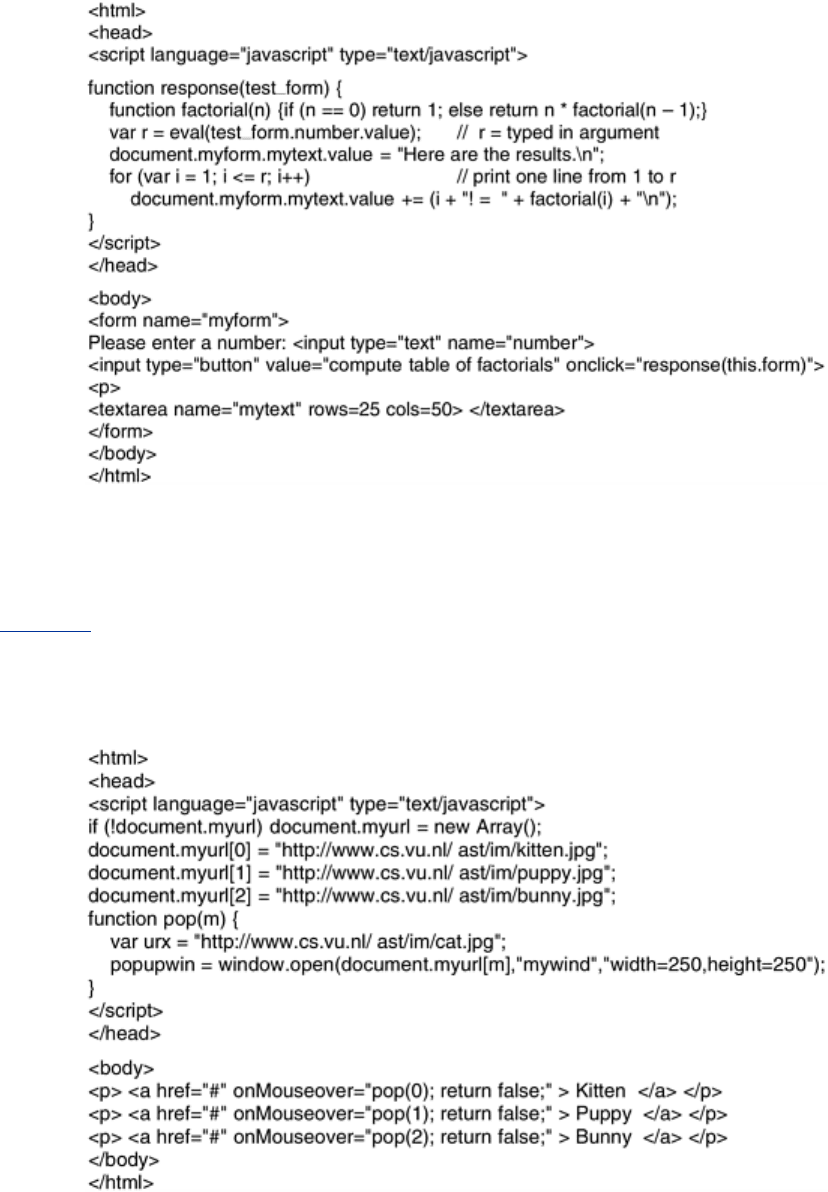
JavaScript can also track mouse motion over objects on the screen. Many JavaScript Web
pages have the property that when the mouse cursor is moved over some text or image,
something happens. Often the image changes or a menu suddenly appears. This kind of
behavior is easy to program in JavaScript and leads to lively Web pages. An example is given
in
Fig. 7-39.
Figure 7-39. An interactive Web page that responds to mouse
movement.
JavaScript is not the only way to make Web pages highly interactive. Another popular method
is through the use of
applets. These are small Java programs that have been compiled into
machine instructions for a virtual computer called the
JVM (Java Virtual Machine). Applets
can be embedded in HTML pages (between
<applet> and </applet>) and interpreted by JVM-
capable browsers. Because Java applets are interpreted rather than directly executed, the Java
interpreter can prevent them from doing Bad Things. At least in theory. In practice, applet
writers have found a nearly endless stream of bugs in the Java I/O libraries to exploit.
501
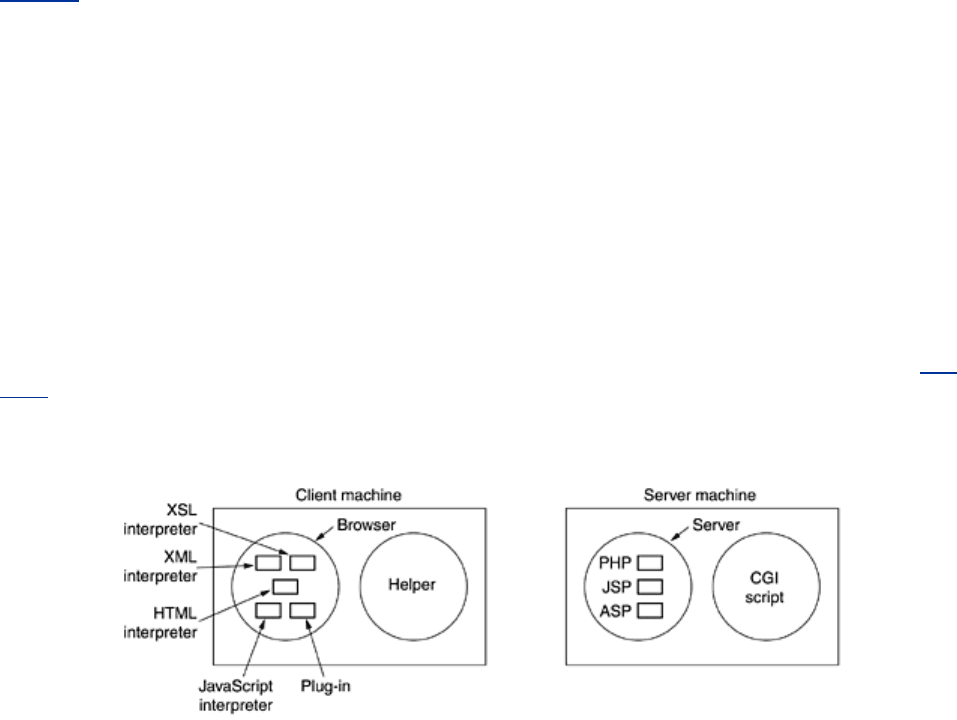
Microsoft's answer to Sun's Java applets was allowing Web pages to hold ActiveX controls,
which are programs compiled to Pentium machine language and executed on the bare
hardware. This feature makes them vastly faster and more flexible than interpreted Java
applets because they can do anything a program can do. When Internet Explorer sees an
ActiveX control in a Web page, it downloads it, verifies its identity, and executes it. However,
downloading and running foreign programs raises security issues, which we will address in
Chap. 8.
Since nearly all browsers can interpret both Java programs and JavaScript, a designer who
wants to make a highly-interactive Web page has a choice of at least two techniques, and if
portability to multiple platforms is not an issue, ActiveX in addition. As a general rule,
JavaScript programs are easier to write, Java applets execute faster, and ActiveX controls run
fastest of all. Also, since all browers implement exactly the same JVM but no two browsers
implement the same version of JavaScript, Java applets are more portable than JavaScript
programs. For more information about JavaScript, there are many books, each with many
(often > 1000) pages. A few examples are (Easttom, 2001; Harris, 2001; and McFedries,
2001).
Before leaving the subject of dynamic Web content, let us briefly summarize what we have
covered so far. Complete Web pages can be generated on-the-fly by various scripts on the
server machine. Once they are received by the browser, they are treated as normal HTML
pages and just displayed. The scripts can be written in Perl, PHP, JSP, or ASP, as shown in
Fig.
7-40.
Figure 7-40. The various ways to generate and display content.
Dynamic content generation is also possible on the client side. Web pages can be written in
XML and then converted to HTML according to an XSL file. JavaScript programs can perform
arbitrary computations. Finally, plug-ins and helper applications can be used to display content
in a variety of formats.
7.3.4 HTTP—The HyperText Transfer Protocol
The transfer protocol used throughout the World Wide Web is HTTP (HyperText Transfer
Protocol
). It specifies what messages clients may send to servers and what responses they
get back in return. Each interaction consists of one ASCII request, followed by one RFC 822
MIME-like response. All clients and all servers must obey this protocol. It is defined in RFC
2616. In this section we will look at some of its more important properties.
Connections
The usual way for a browser to contact a server is to establish a TCP connection to port 80 on
the server's machine, although this procedure is not formally required. The value of using TCP
is that neither browsers nor servers have to worry about lost messages, duplicate messages,
502
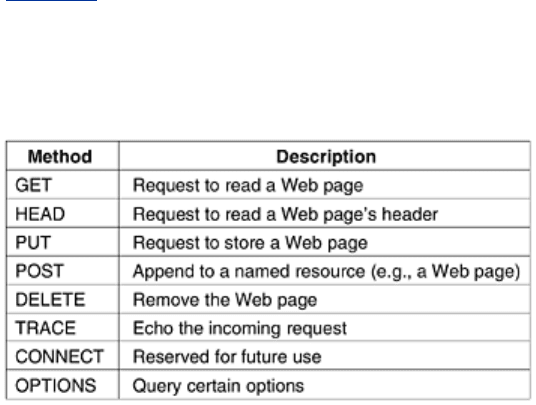
long messages, or acknowledgements. All of these matters are handled by the TCP
implementation.
In HTTP 1.0, after the connection was established, a single request was sent over and a single
response was sent back. Then the TCP connection was released. In a world in which the typical
Web page consisted entirely of HTML text, this method was adequate. Within a few years, the
average Web page contained large numbers of icons, images, and other eye candy, so
establishing a TCP connection to transport a single icon became a very expensive way to
operate.
This observation led to HTTP 1.1, which supports
persistent connections. With them, it is
possible to establish a TCP connection, send a request and get a response, and then send
additional requests and get additional responses. By amortizing the TCP setup and release over
multiple requests, the relative overhead due to TCP is much less per request. It is also possible
to pipeline requests, that is, send request 2 before the response to request 1 has arrived.
Methods
Although HTTP was designed for use in the Web, it has been intentionally made more general
than necessary with an eye to future object-oriented applications. For this reason, operations,
called
methods, other than just requesting a Web page are supported. This generality is what
permitted SOAP to come into existence. Each request consists of one or more lines of ASCII
text, with the first word on the first line being the name of the method requested. The built-in
methods are listed in
Fig. 7-41. For accessing general objects, additional object-specific
methods may also be available. The names are case sensitive, so
GET is a legal method but
get is not.
Figure 7-41. The built-in HTTP request methods.
The
GET method requests the server to send the page (by which we mean object, in the most
general case, but in practice normally just a file). The page is suitably encoded in MIME. The
vast majority of requests to Web servers are
GETs. The usual form of GET is
GET filename HTTP/1.1
where
filename names the resource (file) to be fetched and 1.1 is the protocol version being
used.
The
HEAD method just asks for the message header, without the actual page. This method can
be used to get a page's time of last modification, to collect information for indexing purposes,
or just to test a URL for validity.
The
PUT method is the reverse of GET: instead of reading the page, it writes the page. This
method makes it possible to build a collection of Web pages on a remote server. The body of
503
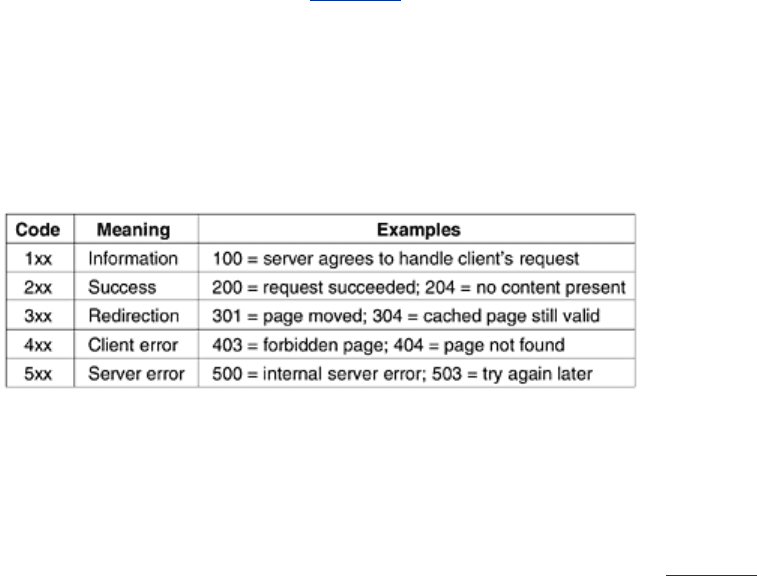
the request contains the page. It may be encoded using MIME, in which case the lines
following the
PUT might include Content-Type and authentication headers, to prove that the
caller indeed has permission to perform the requested operation.
Somewhat similar to
PUT is the POST method. It, too, bears a URL, but instead of replacing the
existing data, the new data is ''appended'' to it in some generalized sense. Posting a message
to a newsgroup or adding a file to a bulletin board system are examples of appending in this
context. In practice, neither
PUT nor POST is used very much.
DELETE does what you might expect: it removes the page. As with PUT, authentication and
permission play a major role here. There is no guarantee that
DELETE succeeds, since even if
the remote HTTP server is willing to delete the page, the underlying file may have a mode that
forbids the HTTP server from modifying or removing it.
The
TRACE method is for debugging. It instructs the server to send back the request. This
method is useful when requests are not being processed correctly and the client wants to know
what request the server actually got.
The
CONNECT method is not currently used. It is reserved for future use.
The
OPTIONS method provides a way for the client to query the server about its properties or
those of a specific file.
Every request gets a response consisting of a status line, and possibly additional information
(e.g., all or part of a Web page). The status line contains a three-digit status code telling
whether the request was satisfied, and if not, why not. The first digit is used to divide the
responses into five major groups, as shown in
Fig. 7-42. The 1xx codes are rarely used in
practice. The 2xx codes mean that the request was handled successfully and the content (if
any) is being returned. The 3xx codes tell the client to look elsewhere, either using a different
URL or in its own cache (discussed later). The 4xx codes mean the request failed due to a
client error such an invalid request or a nonexistent page. Finally, the 5xx errors mean the
server itself has a problem, either due to an error in its code or to a temporary overload.
Figure 7-42. The status code response groups.
Message Headers
The request line (e.g., the line with the GET method) may be followed by additional lines with
more information. They are called
request headers. This information can be compared to the
parameters of a procedure call. Responses may also have
response headers. Some headers
can be used in either direction. A selection of the most important ones is given in
Fig. 7-43.
Figure 7-43. Some HTTP message headers.
504
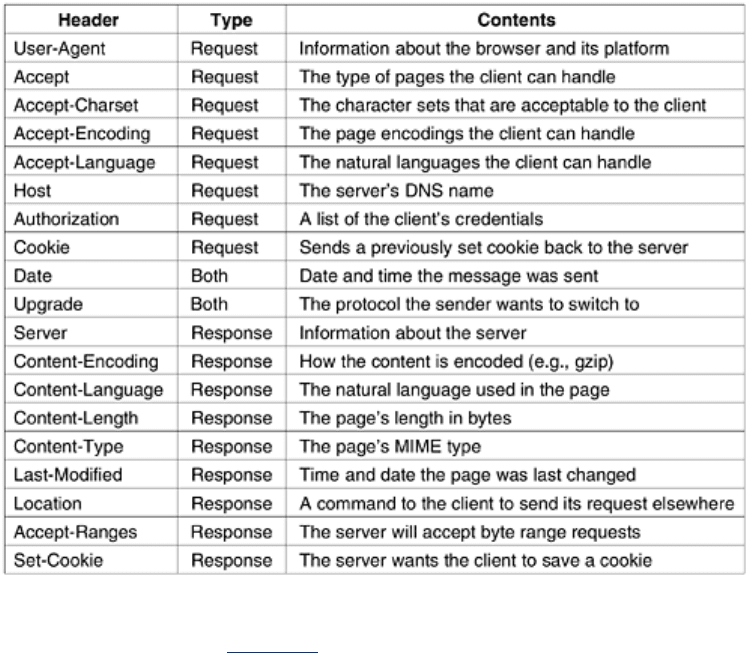
The
User-Agent header allows the client to inform the server about its browser, operating
system, and other properties. In
Fig. 7-34 we saw that the server magically had this
information and could produce it on demand in a PHP script. This header is used by the client
to provide the server with the information.
The four
Accept headers tell the server what the client is willing to accept in the event that it
has a limited repertoire of what is acceptable. The first header specifies the MIME types that
are welcome (e.g., text/html). The second gives the character set (e.g., ISO-8859-5 or
Unicode-1-1). The third deals with compression methods (e.g., gzip). The fourth indicates a
natural language (e.g., Spanish) If the server has a choice of pages, it can use this information
to supply the one the client is looking for. If it is unable to satisfy the request, an error code is
returned and the request fails.
The
Host header names the server. It is taken from the URL. This header is mandatory. It is
used because some IP addresses may serve multiple DNS names and the server needs some
way to tell which host to hand the request to.
The
Authorization header is needed for pages that are protected. In this case, the client may
have to prove it has a right to see the page requested. This header is used for that case.
Although cookies are dealt with in RFC 2109 rather than RFC 2616, they also have two
headers. The
Cookie header is used by clients to return to the server a cookie that was
previously sent by some machine in the server's domain.
The
Date header can be used in both directions and contains the time and date the message
was sent. The
Upgrade header is used to make it easier to make the transition to a future
(possibly incompatible) version of the HTTP protocol. It allows the client to announce what it
can support and the server to assert what it is using.
Now we come to the headers used exclusively by the server in response to requests. The first
one,
Server, allows the server to tell who it is and some of its properties if it wishes.
505

The next four headers, all starting with Content-, allow the server to describe properties of the
page it is sending.
The
Last-Modified header tells when the page was last modified. This header plays an
important role in page caching.
The
Location header is used by the server to inform the client that it should try a different URL.
This can be used if the page has moved or to allow multiple URLs to refer to the same page
(possibly on different servers). It is also used for companies that have a main Web page in the
com domain, but which redirect clients to a national or regional page based on their IP address
or preferred language.
If a page is very large, a small client may not want it all at once. Some servers will accept
requests for byte ranges, so the page can be fetched in multiple small units. The
Accept-
Ranges
header announces the server's willingness to handle this type of partial page request.
The second cookie header,
Set-Cookie, is how servers send cookies to clients. The client is
expected to save the cookie and return it on subsequent requests to the server.
Example HTTP Usage
Because HTTP is an ASCII protocol, it is quite easy for a person at a terminal (as opposed to a
browser) to directly talk to Web servers. All that is needed is a TCP connection to port 80 on
the server. Readers are encouraged to try this scenario personally (preferably from a UNIX
system, because some other systems do not return the connection status). The following
command sequence will do it:
telnet www.ietf.org 80 >log
GET /rfc.html HTTP/1.1
Host: www.ietf.org
close
This sequence of commands starts up a telnet (i.e., TCP) connection to port 80 on IETF's Web
server,
www.ietf.org. The result of the session is redirected to the file log for later inspection.
Then comes the
GET command naming the file and the protocol. The next line is the
mandatory
Host header. The blank line is also required. It signals the server that there are no
more request headers. The
close command instructs the telnet program to break the
connection.
The
log can be inspected using any editor. It should start out similarly to the listing in Fig. 7-
44, unless IETF has changed it recently.
Figure 7-44. The start of the output of www.ietf.org/rfc.html.
506
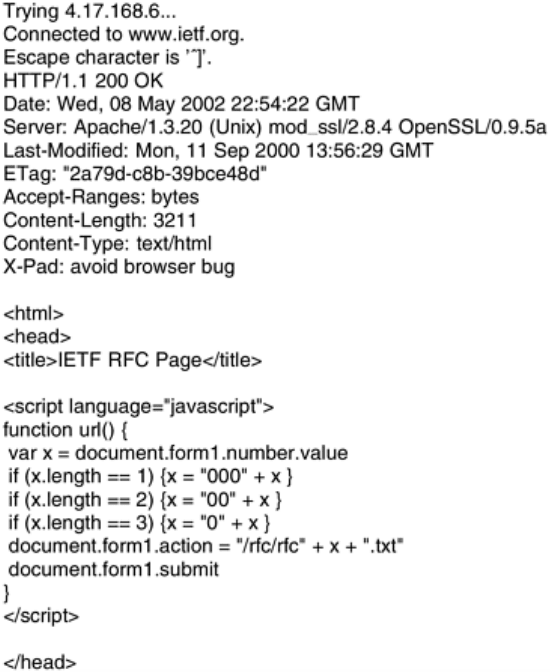
The first three lines are output from the telnet program, not from the remote site. The line
beginning HTTP/1.1 is IETF's response saying that it is willing to talk HTTP/1.1 with you. Then
come a number of headers and then the content. We have seen all the headers already except
for
ETag which is a unique page identifier related to caching, and X-Pad which is nonstandard
and probably a workaround for some buggy browser.
7.3.5 Performance Enhancements
The popularity of the Web has almost been its undoing. Servers, routers, and lines are
frequently overloaded. Many people have begun calling the WWW the World Wide Wait. As a
consequence of these endless delays, researchers have developed various techniques for
improving performance. We will now examine three of them: caching, server replication, and
content delivery networks.
Caching
A fairly simple way to improve performance is to save pages that have been requested in case
they are used again. This technique is especially effective with pages that are visited a great
deal, such as
www.yahoo.com and www.cnn.com. Squirreling away pages for subsequent use
is called
caching. The usual procedure is for some process, called a proxy, to maintain the
cache. To use caching, a browser can be configured to make all page requests to a proxy
instead of to the page's real server. If the proxy has the page, it returns the page immediately.
If not, it fetches the page from||the server, adds it to the cache for future use, and returns it
to the client that requested it.
Two important questions related to caching are as follows:
1. Who should do the caching?
507
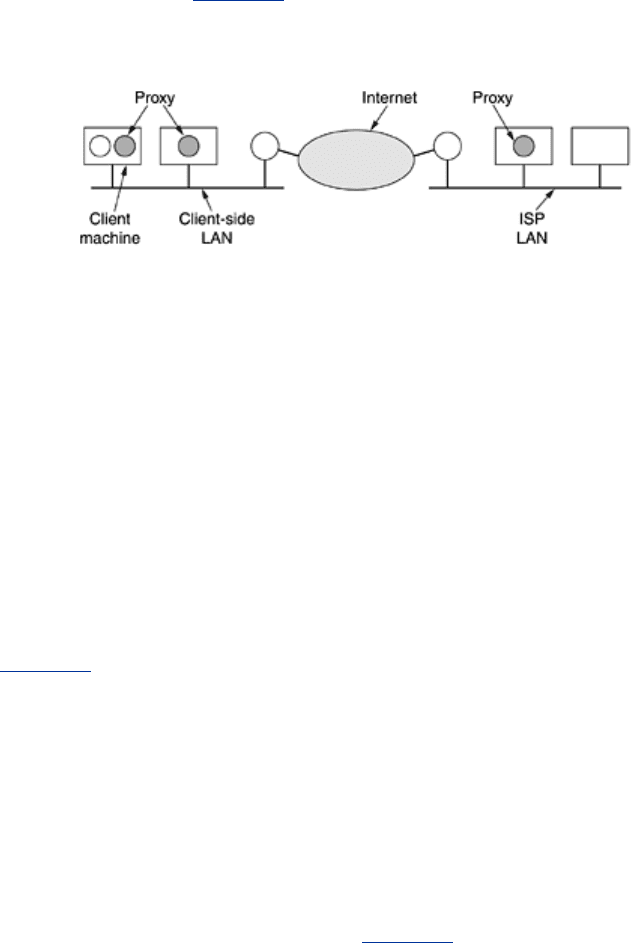
2. How long should pages be cached?
There are several answers to the first question. Individual PCs often run proxies so they can
quickly look up pages previously visited. On a company LAN, the proxy is often a machine
shared by all the machines on the LAN, so if one user looks at a certain page and then another
one on the same LAN wants the same page, it can be fetched from the proxy's cache. Many
ISPs also run proxies, in order to speed up access for all their customers. Often all of these
caches operate at the same time, so requests first go to the local proxy. If that fails, the local
proxy queries the LAN proxy. If that fails, the LAN proxy tries the ISP proxy. The latter must
succeed, either from its cache, a higher-level cache, or from the server itself. A scheme
involving multiple caches tried in sequence is called
hierarchical caching. A possible
implementation is illustrated in
Fig. 7-45.
Figure 7-45. Hierarchical caching with three proxies.
How long should pages be cached is a bit trickier. Some pages should not be cached at all. For
example, a page containing the prices of the 50 most active stocks changes every second. If it
were to be cached, a user getting a copy from the cache would get
stale (i.e., obsolete) data.
On the other hand, once the stock exchange has closed for the day, that page will remain valid
for hours or days, until the next trading session starts. Thus, the cacheability of a page may
vary wildly over time.
The key issue with determining when to evict a page from the cache is how much staleness
users are willing to put up with (since cached pages are kept on disk, the amount of storage
consumed is rarely an issue). If a proxy throws out pages quickly, it will rarely return a stale
page but it will also not be very effective (i.e., have a low hit rate). If it keeps pages too long,
it may have a high hit rate but at the expense of often returning stale pages.
There are two approaches to dealing with this problem. The first one uses a heuristic to guess
how long to keep each page. A common one is to base the holding time on the
Last-Modified
header (see
Fig. 7-43). If a page was modified an hour ago, it is held in the cache for an hour.
If it was modified a year ago, it is obviously a very stable page (say, a list of the gods from
Greek and Roman mythology), so it can be cached for a year with a reasonable expectation of
it not changing during the year. While this heuristic often works well in practice, it does return
stale pages from time to time.
The other approach is more expensive but eliminates the possibility of stale pages by using
special features of RFC 2616 that deal with cache management. One of the most useful of
these features is the
If-Modified-Since request header, which a proxy can send to a server. It
specifies the page the proxy wants and the time the cached page was last modified (from the
Last-Modified header). If the page has not been modified since then, the server sends back a
short
Not Modified message (status code 304 in Fig. 7-42), which instructs the proxy to use
the cached page. If the page has been modified since then, the new page is returned. While
this approach always requires a request message and a reply message, the reply message will
be very short when the cache entry is still valid.
These two approaches can easily be combined. For the first ∆
T after fetching the page, the
proxy just returns it to clients asking for it. After the page has been around for a while, the
508
proxy uses If-Modified-Since messages to check on its freshness. Choosing ∆T invariably
involves some kind of heuristic, depending on how long ago the page was last modified.
Web pages containing dynamic content (e.g., generated by a PHP script) should never be
cached since the parameters may be different next time. To handle this and other cases, there
is a general mechanism for a server to instruct all proxies along the path back to the client not
to use the current page again without verifying its freshness. This mechanism can also be used
for any page expected to change quickly. A variety of other cache control mechanisms are also
defined in RFC 2616.
Yet another approach to improving performance is proactive caching. When a proxy fetches a
page from a server, it can inspect the page to see if there are any hyperlinks on it. If so, it can
issue requests to the relevant servers to preload the cache with the pages pointed to, just in
case they are needed. This technique may reduce access time on subsequent requests, but it
may also flood the communication lines with pages that are never needed.
Clearly, Web caching is far from trivial. A lot more can be said about it. In fact, entire books
have been written about it, for example (Rabinovich and Spatscheck, 2002; and Wessels,
2001); But it is time for us to move on to the next topic.
Server Replication
Caching is a client-side technique for improving performance, but server-side techniques also
exist. The most common approach that servers take to improve performance is to replicate
their contents at multiple, widely-separated locations. This technique is sometimes called
mirroring.
A typical use of mirroring is for a company's main Web page to contain a few images along
with links for, say, the company's Eastern, Western, Northern, and Southern regional Web
sites. The user then clicks on the nearest one to get to that server. From then on, all requests
go to the server selected.
Mirrored sites are generally completely static. The company decides where it wants to place
the mirrors, arranges for a server in each region, and puts more or less the full content at each
location (possibly omitting the snow blowers from the Miami site and the beach blankets from
the Anchorage site). The choice of sites generally remains stable for months or years.
Unfortunately, the Web has a phenomenon known as
flash crowds in which a Web site that
was previously an unknown, unvisited, backwater all of a sudden becomes the center of the
known universe. For example, until Nov. 6, 2000, the Florida Secretary of State's Web site,
www.dos.state.fl.us, was quietly providing minutes of the meetings of the Florida State cabinet
and instructions on how to become a notary in Florida. But on Nov. 7, 2000, when the U.S.
Presidency suddenly hinged on a few thousand disputed votes in a handful of Florida counties,
it became one of the top five Web sites in the world. Needless to say, it could not handle the
load and nearly died trying.
What is needed is a way for a Web site that suddenly notices a massive increase in traffic to
automatically clone itself at as many locations as needed and keep those sites operational until
the storm passes, at which time it shuts many or all of them down. To have this ability, a site
needs an agreement in advance with some company that owns many hosting sites, saying that
it can create replicas on demand and pay for the capacity it actually uses.
An even more flexible strategy is to create dynamic replicas on a per-page basis depending on
where the traffic is coming from. Some research on this topic is reported in (Pierre et al.,
2001; and Pierre et al., 2002).
509

Content Delivery Networks
The brilliance of capitalism is that somebody has figured out how to make money from the
World Wide Wait. It works like this. Companies called
CDNs (Content Delivery Networks)
talk to content providers (music sites, newspapers, and others that want their content easily
and rapidly available) and offer to deliver their content to end users efficiently for a fee. After
the contract is signed, the content owner gives the CDN the contents of its Web site for
preprocessing (discussed shortly) and then distribution.
Then the CDN talks to large numbers of ISPs and offers to pay them well for permission to
place a remotely-managed server bulging with valuable content on their LANs. Not only is this
a source of income, but it also provides the ISP's customers with excellent response time for
getting at the CDN's content, thereby giving the ISP a competitive advantage over other ISPs
that have not taken the free money from the CDN. Under these conditions, signing up with a
CDN is kind of a no-brainer for the ISP. As a consequence, the largest CDNs have more than
10,000 servers deployed all over the world.
With the content replicated at thousands of sites worldwide, there is clearly great potential for
improving performance. However, to make this work, there has to be a way to redirect the
client's request to the nearest CDN server, preferably one colocated at the client's ISP. Also,
this redirection must be done without modifying DNS or any other part of the Internet's
standard infrastructure. A slightly simplified description of how Akamai, the largest CDN, does
it follows.
The whole process starts when the content provider hands the CDN its Web site. The CDN then
runs each page through a preprocessor that replaces all the URLs with modified ones. The
working model behind this strategy is that the content provider's Web site consists of many
pages that are tiny (just HTML text), but that these pages often link to large files, such as
images, audio, and video. The modified HTML pages are stored on the content provider's
server and are fetched in the usual way; it is the images, audio, and video that go on the
CDN's servers.
To see how this scheme actually works, consider Furry Video's Web page of
Fig. 7-46(a). After
preprocessing, it is transformed to
Fig. 7-46(b) and placed on Furry Video's server as
www.furryvideo.com/index.html.
Figure 7-46. (a) Original Web page. (b) Same page after
transformation.
510
